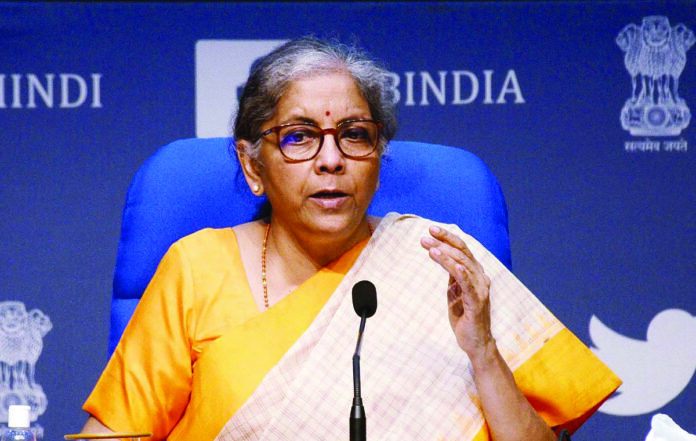Indian Finance Minister Nirmala Sitharam presented the budget amid rumpus. She stammered a lot and avoided reading out defence allocations. When questioned why the finance minister didn’t mention the defence budget allocation during her speech, NITI Aayog Vice Chairman Rajiv Kumar said that It (Defence) was not a part of the speech but it was there in the Budget. Opposition leaders have criticised the budget for being pro-industrialist. Instead of cutting wasteful expenditure, the budget provides for disinvestment of assets.
The true quantum of the allocations could be ascertained when the actual documents and Explanatory Memorandum become available. However, information published in the media is shocking.
Riding the China bogey, the armed forces went on a spending spree. Prime Minister Narendra Modi had told the all-party conference that China had not trespassed on an inch of Indian territory. However, the Indian Armed forces exploited the China factor to overspend their capital budget by Rs 23,000 crore last year. Still, the new budget provided a 0.4% hike in capital expenditure. The budget allocated a further Rs 1.35 lakh crore for additional capital expenditure. The total outlay for the defence ministry, including the aforementioned capital expenditure, is Rs 4.78 lakh crores.
The total allocation for defence services in 2021-22, including pensions, is Rs 4.78 lakh crore compared to Rs 4.71 lakh crore, last year. Without pension allocation, it is Rs 3.62 lakh crore in comparison to last year’s Rs. 3.37 lakh crore.
The capital is meant to purchase fighters, submarines, helicopters and other modern military systems. It has been increased from Rs 1, 13,734 crore last year to Rs 1, 35,060 crore, a whopping 19 percent hike. During the Ladakh standoff with China, a lot of emergency purchases were made.
Last year, the IAF overspent Rs 11,773 crore and the Navy overspent Rs 10,854 crore. In comparison, the Army overspent Rs 821 crore.
The Indian Navy spent nearly Rs 5000 crore extra on its fleet. The budget documents cryptically say, `The Air Force increased its expenditure to procure several equipment and special projects’.
The engineers also fished in hot waters. While the estimated budget for civil work was Rs 14,500 crore, it increased to Rs 15,914.06 crore as the government spent on building infrastructure in border areas.
In this year’s budget, the capital outlay for the Indian Army is Rs 36,481 crore, for Air Force it is Rs 53, 214 crore and for the Navy, it’s Rs 33,253 crore.
Ignoring principles of financial propriety, the government has created a non-lapsable fund for defence. The details are a guarded secret.
To hoodwink the general reader, India deflates its military expenditure through clever stratagems. It publishes its `demands for grants for “defence” services’ separately from demands for grants of civil ministries that includes its defence ministry (MoD).
Only such states survived as were able to strike a balance between security and welfare. Garrison or warrior states vanished as if they never existed. Client states, living on doles from powerful states, ended up as banana republics.
It clubs military pensions in civil estimates. There are several other quasi-military provisions that are similarly shoved in civil estimates. Such concealed defence provisions include public-sector undertakings under MoD like dockyards, machine tool industries, and Bharat Heavy Electrical Limited, besides space-and-nuclear/chemical/biological-research projects, border and strategic roads and a host of paramilitary forces (Border Security Force, Industrial Reserve Force, etc.).
It does this to `lower’ its military budget as a proportion of its GNP. Through such ploys, India, as compared with its neighbours, gets a favourable image in The Military Balance, Jane’s Defense, and other international publications.
The analyses of India’s military spending suffer from an inherent shortcoming. They have to rely on figures showcased by India on official websites. As such, the true quantum of military budget is deflated. The deflated figures are used to make inter-country, inter-region or endogenous comparisons like military budget as a proportion of total civil outlay.
Indian policy of increasing her military outlays is based on strategic misconceptions. India thinks it would be suicidal for Pakistan to increase her military budget pari passu with India’s. In any case, Pakistan could not afford to spend more than half the increase in India’s military budget. A higher allocation would sap Pakistan’s future growth resource potential.
India’s perceptions historically have proved wrong. Pakistan neutralised the impact of this differential economic performance by going nuclear, and developing tactical nuclear weapons.
The surreptitious manner in which India’s defence budget has been presented should open the eyes of Pakistan’s defence budget critics. The main criticism is that defence outlay is given in a lump sum. But, that does not mean it is secret. Details are available with the defence ministry, which is under its minister, not the Army chief.
The main points of criticism are thus articulated by Hafiz A. Pasha, in Growth and Inequality in Pakistan: Agenda for Reforms:
a.`The military has been considered as a kind of `sacred cow’ in Pakistan. The perception has been augmented by the role played either directly or indirectly by the defence establishment in the running of the affairs of the country’.
- `The most vivid demonstration… is that the defence budget is not subject to any Parliamentary scrutiny…This is over30 percent of the total.’.
- ‘defence expenditure has gone up from 3.4 percent of the GDP in 2007-08 to 4 percent of the GDP in 2017-18.’
Parliamentarians lack the ability to scrutinize the budget. Budgetary analysis is a technical task which could be done only by qualified people. India’s rising defence outlays ratchet up Pakistan’s. It is smaller than India, with a smaller GDP,.
Pakistan’s defence demands undergo a rigorous scrutiny by relevant parliamentary committees and audit bodies. Legislators and the Ministry are properly briefed about the need for provisions.
Most legislators lack acumen to analyse numerical rigmarole. So they themselves do not wish to be bothered with the job being done by competent professionals in various ministries and parliamentary committees.
Pakistan should separate expenditure of forces to defend China Pakistan Economic Corridor and key installations, including Parliament, from normal demands.
Only such states survived as were able to strike a balance between security and welfare. Garrison or warrior states vanished as if they never existed. Client states, living on doles from powerful states, ended up as banana republics.
Just think of Austria-Hungary, Spain, Portugal, the Netherlands, Sweden and Tsarist Russia and even the erstwhile USSR.
A common feature of all strong states had been that they had strong military and civil institutions, de jure capability to defend their territory and policies that favoured the citizenry rather than dominant classes.























Writer is foolishly copy pasting Indian media’s critical initial analysis of Indian budget. Further, budget is future planning of earning and expenditures and provisional figures for current year. Please stop idiotic comparison of India’s defence budget with Pakistan’s or any other nation. Every nation has its own plans and requirements. 😊
If a Pakistani is wasting his time and writing about Indian budget in a negative fashion, for sure indian budget is right on track!
Beggar’s Awe! looking at Billions of Dollar’s budget? In how many years beggars can raise these amounts 24×7 begging?